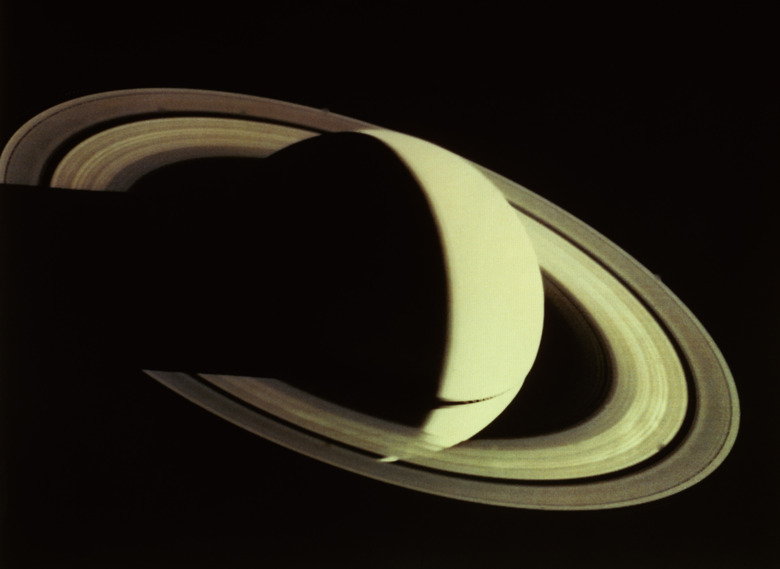Does Saturn Reflect Light?
The planet Saturn not only reflects sunlight better than most of the terrestrial planets in the solar system, but it radiates with its own light. When it's at its brightest, with its ring system open and in full view, few stars can outshine it. The planet has a distinctive yellow color, which is caused by the presence of ammonia ice in the thick clouds in its upper atmosphere that shroud its complex atmosphere.
Albedo and Magnitude
Albedo and Magnitude
Saturn's albedo, which is a measure of the fraction of incident light that a space object reflects, is 0.47. That is the least of any of the Jovian planets, but it's greater than any of the rocky terrestrial planets except for Venus, which is covered by dense clouds. Saturn's apparent magnitude, which is a measure of its brightness on Earth — corrected for Earth's atmosphere — varies from minus 0.5 to 0.9. Saturn is at its brightest when its rings are open, and it shines brighter than any star except for Sirius and Canopus.
A Dim Yellow World
A Dim Yellow World
From afar, Saturn shines with a ochre or golden hue, which is produced as sunlight reflects off its upper-atmospheric clouds. The chemical responsible for the yellowish tinge is ammonia, which exists as a trace element in the hydrogen- and helium-rich atmosphere. Saturn's complex atmosphere is infused with reds and blues caused by the presence of hydrogen sulfide and water vapor, and the planet would resemble Jupiter if it didn't have such a heavy cloud cover. Saturn is a smaller planet than Jupiter, and its gravitation isn't as strong, which is why its cloud layer is thicker and rarely separates to reveal lower layers.
An Energy Generator
An Energy Generator
Although Saturn reflects sunlight, it also produces from two to three times as much energy as it receives from the sun, which is even more energy than Jupiter produces. Unlike Jupiter, which simply hasn't cooled since its formation, Saturn has a constant rain of helium atoms, which are attracted to its core by gravity. As the helium atoms fall and gain energy, they collide with hydrogen molecules, which are more abundant, and the force of friction slows them down and generates heat. The heat raises the average temperature of the planet to 130 kelvins (minus 225 degrees Fahrenheit). Without it, the average temperature would probably be about 80 kelvins (minus 315 degrees Fahrenheit).
Saturn's Rings
Saturn's Rings
Saturn's extensive ring system is 273,600 kilometers (170,00 miles) across and about 30 feet thick. Unlike the ring systems of the other Jovian worlds, which are composed of dark rocks and dust, Saturn's system contains a preponderance of ice rocks, which may be the leftovers of a large body that broke up within when it approached too closely. The rings also contain water vapor, some of which is fed from its moons. Water and ice are both highly reflective. One of Saturn's moons, Enceladus, is covered with ice, making it one of the highest-albedo bodies in the solar system.
Cite This Article
MLA
Deziel, Chris. "Does Saturn Reflect Light?" sciencing.com, https://www.sciencing.com/does-saturn-reflect-light-12731158/. 9 January 2014.
APA
Deziel, Chris. (2014, January 9). Does Saturn Reflect Light?. sciencing.com. Retrieved from https://www.sciencing.com/does-saturn-reflect-light-12731158/
Chicago
Deziel, Chris. Does Saturn Reflect Light? last modified March 24, 2022. https://www.sciencing.com/does-saturn-reflect-light-12731158/
